Asteroids - Study guides, Class notes & Summaries
Looking for the best study guides, study notes and summaries about Asteroids? On this page you'll find 360 study documents about Asteroids.
Page 4 out of 360 results
Sort by
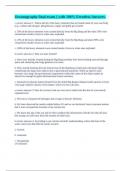
-
Oceanography final exam || with 100% Errorless Answers.
- Exam (elaborations) • 51 pages • 2024
- Available in package deal
-
- $15.99
- + learn more
c correct answers 1. Where did all of the heavy elements that are found inside of your own body (e.g., carbon and nitrogen, phosphorous, copper and gold) get created? a. 50% of the heavy elements were created directly from the Big Bang and the other 50% were created later inside of stars or when stars exploded. b. 10% of the heavy elements were created directly from the Big Bang and about 90% were created later inside of stars or when stars exploded. c. 100% of the heavy elements were c...
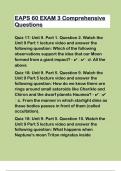
-
EAPS 60 EXAM 3 Comprehensive Questions With Correct Researched Answers|14 Pages
- Exam (elaborations) • 14 pages • 2024
- Available in package deal
-
- $8.49
- + learn more
Quiz 17: Unit 9. Part 1. Question 2. Watch the Unit 9 Part 1 lecture video and answer the following question: Which of the following observations support the idea that our Moon formed from a giant impact? - ️️d. All the above Quiz 18: Unit 9. Part 5. Question 9. Watch the Unit 9 Part 5 lecture video and answer the following question: How do we know there are rings around small asteroids like Chariklo and Chiron and the dwarf planets Haumea? - ️️c. From the manner in which starlight dims...
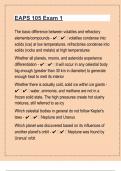
-
EAPS 105|71 Exam 1 Questions With Answers| Success Guaranteed
- Exam (elaborations) • 12 pages • 2024
- Available in package deal
-
- $7.99
- + learn more
The basic difference between volatiles and refractory elements/compounds - ️️volatiles condense into solids (ice) at low temperatures. refractories condense into solids (rocks and metals) at high temperatures Whether all planets, moons, and asteroids experience differentiation - ️️it will occur in any celestial body big enough (greater than 30 km in diameter) to generate enough heat to melt its interior Whether there is actually cold, solid ice within ice giants - ️️water, ammonia,...
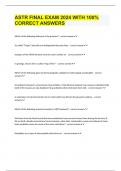
-
ASTR FINAL EXAM 2024 WITH 100% CORRECT ANSWERS
- Exam (elaborations) • 7 pages • 2024
-
- $15.49
- + learn more
Which of the following distances is the greatest? - correct answer So called "Trojan" asteroids are distinguished because they, - correct answer Isotopes of the SAME element have the same number of, - correct answer In geology, what is the so called "ring of fire?" - correct answer Which of the following types of electromagnetic radiation has the longest wavelength? - correct answer According to Newton's universal law of gravitation, if the distance between two masses is...
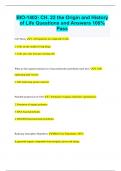
-
BIO-1402- CH. 22 the Origin and History of Life Questions and Answers 100% Pass
- Exam (elaborations) • 16 pages • 2024
- Available in package deal
-
- $9.99
- + learn more
BIO-1402- CH. 22 the Origin and History of Life Questions and Answers 100% Pass Cell Theory 1. All organisms are composed of cells 2. Cells are the smallest living things 3. Cells arise only from pre-existing cells What are the required minimal set of macromolecules protobionts must have? 1. Self- replicating lipid vesicles 2. Self-replicating genetic material. Plausible progression of Cells 1. Formation of organic molecules (spontaneous) 2. Formation of organic polymers 3. ...
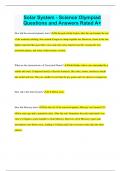
-
Solar System - Science Olympiad Questions and Answers Rated A+
- Exam (elaborations) • 31 pages • 2024
- Available in package deal
-
- $10.49
- + learn more
Solar System - Science Olympiad Questions and Answers Rated A+ How did the terrestrial planets form? In the proto-Solar-Sytem, after the sun formed, the rest of the materials orbiting close around it began to clump together too. However, closer to the sun, lighter materials like gases blew away and only rocky material was left, causing the four terrestrial planets, and some of their moons, to form. What are the characteristics of Terrestrial Planets? Solid bodies with a core surrounded...
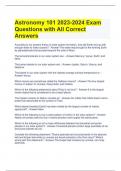
-
Astronomy 101 2023-2024 Exam Questions with All Correct Answers
- Exam (elaborations) • 23 pages • 2023
- Available in package deal
-
- $13.99
- + learn more
Astronomy 101 2023-2024 Exam Questions with All Correct Answers According to our present theory of solar system formation, how did Earth end up with enough water to make oceans? - Answer-The water was brought to the forming Earth by planetesimals that accreted beyond the orbit of Mars. The terrestrial planets in our solar system are: - Answer-Mercury, Venus, Earth, and Mars. The jovian planets in our solar system are: - Answer-Jupiter, Saturn, Uranus, and Neptune. The planet in our so...

-
AST101 Clicker Quizes UofT Questions and Answers 100% Pass
- Exam (elaborations) • 32 pages • 2024
-
- $9.99
- + learn more
AST101 Clicker Quizes UofT Questions and Answers 100% Pass What does the term "Solar System" mean? The Sun, the planets, and all of their moons What does the term "Universe" mean? The totality of all space, time, energy, and matter Earth is 1 AU from the Sun. What is the maximumpossible separation between Earth and Mars? (Hint: Mars is the next farthest planet from the Sun) 2.5 AU A 'light year' is a measure of: distance Stars are... balls of plasma which produce energy ...
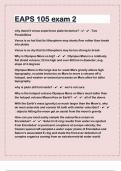
-
EAPS 105|95 exam 2 Questions With Answers|2025
- Exam (elaborations) • 18 pages • 2024
- Available in package deal
-
- $8.49
- + learn more
why doesn't venus experience plate tectonics? - ️️Two Possibilities Venus is so hot that its lithosphere may slowly flow rather than break into plates Venus is so dry that its lithosphere may be too strong to break Why is Olympus Mons so big? - ️️Olympus Mons is a relatively flat shield volcano; 22 km high and over 600 km in diameter; avg. slope of 4 degrees Olympus Mons is this large due to: weak Mars gravity allows high topography, no plate tectonics on Mars to move a volcano of...
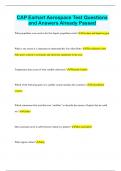
-
CAP Earhart Aerospace Test Questions and Answers Already Passed
- Exam (elaborations) • 22 pages • 2024
- Available in package deal
-
- $9.99
- + learn more
CAP Earhart Aerospace Test Questions and Answers Already Passed What propellants were used in the first liquid- propellant rocket? Gasoline and liquid oxygen What is one reason it is important to understand the Van Allen Belts? The radiation in the belts poses a threat to astronauts and electronic equipment in the area. Temperature data is part of what satellite subsystem? Thermal Control Which of the following parts of a satellite system includes the customers? Constellation sy...

Study stress? For sellers on Stuvia, these are actually golden times. KA-CHING! Earn from your study resources too and start uploading now. Discover all about earning on Stuvia


